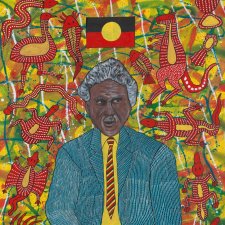Robert Campbell Junior, urban Aboriginal artist, was a Ngaku/Dhunghutti man who grew up in Kempsey, New South Wales. Although in the 1950s the Indigenous people of the region were actively discouraged from pursuing any of their traditions, Campbell's father was a boomerang maker and Campbell observed him at his craft, shaping wood and inscribing designs. Educated at the Burnt Bridge Mission School, from the age of fourteen Campbell worked in a series of menial jobs in Kempsey and Sydney. When he returned to his birthplace, he started to paint in earnest, depicting, as he said, his personal response to his environment, 'both past and present, the people, the landscape, and my own relationship with both . . . Aboriginal culture naturally becomes a part of my work as a reflection of my heritage and ancestry, but my message is to all people.' In the 1980s, shows in Sydney and Melbourne at the Roslyn Oxley and Christine Abrahams galleries brought him critical recognition. In 1987 he was the artist in residence at the Tin Sheds at the University of Sydney and he was commissioned to create a poster for the Bicentennial Authority. In the late 1980s he travelled to Ramingining in the Northern Territory; he found the experience of the traditional community totally new, and to a certain extent the visit influenced his subsequent work. His portraits My Brother Mac Silva 1989 and Sammy Alfie Drew: Local Macleay Aboriginal Sporting Identity 1990 were hung in the Archibald; in 1990 he had a solo show at the Rebecca Hossack Gallery in London. Campbell's picture The Provider of the Tucker 1987 was hung in the National Portrait Gallery exhibition A Face in the Crowd in 1997; his Aboriginal Embassy 1986 was shown in Open Air: Portraits and Landscapes in 2008.
- About us
- Support the Gallery
- Venue hire
- Publications
- Research library
- Organisation chart
- Employment
- Contact us
- Make a booking
- Onsite programs
- Online programs
- School visit information
- Learning resources
- Little Darlings
- Professional learning







